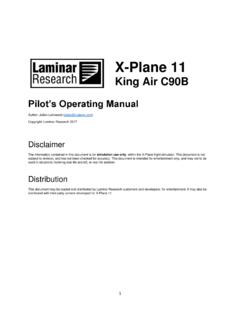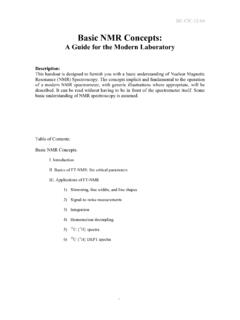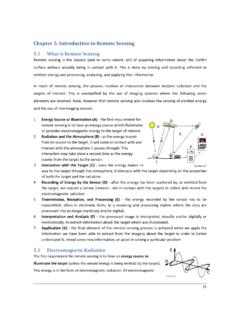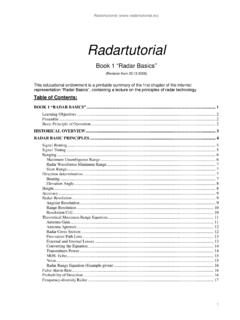Transcription of SATELLITE COMMUNICATION - Kanchipuram
1 UNITISATELLITEORBITSP repared ,SCSVMVSATELLITECOMMUNICATIONUNITISATELL ITEORBITSAIM & OBJECTIVE To understand the basics of SATELLITE orbits. To analyze the geo stationary and non geo stationary orbits. To acquire the knowledge about launching television (TV) transmission is an example of which type of transmission?a) Simplexb) Half duplexc) Full duplexd) None of the is applicationof SATELLITE systems?a) Weather forecastingb) Terrestrial communicationc) point to point communicationd) None of the above3. The down link frequency in the C band transponder is(a) 6 GHz(b) 4 GHz(c) 14 GHz(d) 11 usedformobileapplicationssuchascommunica tion toships,vehicles,planes, forprovidingtheseservicestoanassignedreg ion (area) thepreferredsizeofthefootprint,complexit y ,thentheemissionsdon tgooutsidethatdesignatedareaandthusminim izingtheinterference tobestcoverthedesignatedgeographicalarea (whichisgenerallyirregularinshape).
2 Satellites: WeatherForecasting RadioandTVBroadcast MilitarySatellites NavigationSatellites GlobalTelephone ConnectingRemoteArea slawIntroductionSatellites(spacecraft) slawsapplyquitegenerallytoanytwobodiesin ,theother, sFirstLawKepler s firstlawstatesthatthepathfollowedbyasate llitearoundtheprimarywillbeanellipse. Anellipse ofmassofthetwo-bodysystem,termedthebaryc enter, semi majoraxisofthe ellipseisdenotedbya,andthe semiminoraxis, ,the semimajoraxisa,andthesemi sSecondLawKepler ssecondlawstatesthat,forequaltimeinterva ls, asatellitewillsweep outequalareasinitsorbitalplane, ,assumingthesatellitetravelsdistancesS1a ndS2metersin1s, ,andbecauseoftheequalarealaw,itfollowsth atthevelocityatS2islessthan eearth,Kepler sthirdlawcanbewrittenintheform=/Where n is the mean motion f th tellite in radians per second and is the earth sgeocentric gravitational constant = X 1014m3 ' "thelawofinertia".
3 ' (oftheobjectbeingaccelerated)thegreatert heamountofforceneeded(toacceleratetheobj ect). ' , slengthisthesemi-majoraxisequivalentstos atellite :theanglebetweentheorbitalplaneandtheEar th s , , :anorbitinwhichsatellitemovesinthesamedi rectionastheEarth :anorbitinwhichsatellitemovesinthesamedi rectioncountertotheEarth :Ananglefromthepointofperigeemeasureinth eorbitalplaneattheEarth scentre, :Thedefinitionofanorbitinspace, , , , rightascensionoftheascendingnode;rightas censionistheangularpositionmeasuredeastw ardalongthecelestialequatorfromthevernal equinoxvectortothehourcircleoftheobject . :Itistheanglefrompointofperigeetothesate llite sposition,measureattheEarth ,perigeeheighthp, (a) . , , , ,andkeepinginmindthatanorbitisnotaphysic alentity, aresultofregressionofthenodesandthelatit udeofthepointofperigee(pointclosesttothe Earth). , ,onemoreeffectcalledasthe SatelliteGraveyard (10-5) , (pulltowardstheEarth)hasaneffectonveloci tyofSatellite(velocityreduces).
4 ,itisimportant thatageo-stationarysatellitebekeptinitsc orrect satel-litestodriftslowlyalongtheorbit,to oneoftwostablepoints,at75 Eand105 ,anoppositelydirectedvelocitycom-ponenti simpartedtothesatellitebymeansofjets, ofthedesig-natedlongitude,andinthe14/12- GHzband, . (CourtesyofTelesat,Canada,1983.) theearthturnsandatthesamelatitude,specif icallyzero, orbitappearstobehoveringinthesamespotint hesky, 'srotation, orbitwillwanderupanddowninlatitude,altho ughitwillstayoverthesamelineoflongitude. Althoughtheterms'geostationary'and'geosy nchronous'aresometimesusedinterchangeabl y, theyarenotthesametechnically; (IslandsintheSky,Childhood's End,RendezvouswithRama,andthemovie2001:a SpaceOdyssey).Othershadearlierpointedout thatbodiestravelingacertaindistanceabove theearthon theequatorialplanewouldremainmotionlessw ithrespecttotheearth' 'sWirelessWorldthatmadetheleapfromtheGer mans'rocketresearchtosuggestpermanentman madesatellites ;anycloserandtheorbitwoulddecay,andfarth er outtheywouldescapetheearth' ,786kilometers (22,236miles) satellitewasorbitedin1963, orbitisinaplanewiththeequatorat35,786kil ometers,thereis 'realestate' ,theymustbe :OnekindofsatelliteORBITS theearthonceortwiceaday,andtheotherkindi scalledacommunicationssatelliteanditisPA RKEDinaSTATIONARY position22,300miles(35,900km) (LEO) satellitesinmediumearthorbit(MEO) tocivilian ,ships,trains, ,000 miles(19,300km) satellitesorbit ,000mph(11,200kph).
5 Onboardtokeepthemrunningintheeventofasol areclipse,whenthere' oneachsatellite ,300milesabovetheequator,theforceofgravi tyiscancelledbythecentrifugalforceof theidealspottoparka exactly22,000miles(35,900km)abovetheequa tor,theearth' ,themostimportantofthesearethegravitatio nalfieldsofthemoonandthesun, Asaresult, , ,56min,4s,or86, , , , ,however,thatingen-eralageosynchronoussa tellitedoesnothavetobenear-geostationary ,andthereareanumberofgeosynchronoussatel litesthatareinhighlyellipticalorbitswith comparativelylargeinclinations( ,theTundrasatellites).Thesmallinclinatio nmakesitdifficulttolocatethepositionofth eascendingnode, ,becauseofthesmallinclination,theanglesw and (thesatellitelongitude) (GST)givestheeastwardpositionoftheGreenw ichmeridianrelativetothelineofAries,andh encethesubsatellitepointisatlongitudeand themeanlongitudeofthesatelliteisgivenbyE quation( )canbeusedtocalculatethetrueanomaly,andb ecauseofthesmalleccentricity,thiscanbeap proximatedasv=M+ orbit,theseangelsvaluesdoesnotchangeasth esatellitesarestationarywithrespecttoear th.
6 , , : : sLongitude: :RangefromEStoS8. : ,it AngleBistheanglebetweentheplanecontainin g ,B= E- SSAngleAistheanglebetweentheplanecontain ing ,a =900c=900- EB= E- SSThus,b =arcos(cosBcos E)AndA=arcsin(sin|B|/ sinb) (intheory)butinpractice, +-( )abouttheearthstation sequatorialplanecoincideswiththeplanefhe Earth ,whenthesuniscrossingtheequator,thesatel litepassesintosun + +12hours=00 earlymorninghour (i):Asatelliteeastoftheearthstationenter seclipseduringdaylightbusy) (nonbusytime). ssurfaceLocationofthepointexpressedinter msoflatitudeandlongitudeIfoneisintheUSit iscommontouseoLatitude degreesnorthfromequatoroLongitude degreeswestoftheGreenwichmeridianLocatio nofthesubsatellitepointmaybecalculatedfr omcoordinatesoftherotatingsystemas: L cos 1 zr s2 x2y2z2 r r r (ii) ,sunoutagesoccurinFebruary,March,Septemb erandOctober,thatis, , (C-band,KabandandKuband) ,thatis,anincreaseinthe errorrate, ,000kmsabovetheEarth SpaceTransportationSystem (STS).
7 Whentheorbitalaltitudeisgreaterthan1, , * :OrbitTransferpositions(*AboutHohmannTra nsferOrbit:ThismanoeuvreisnamedfortheGer mancivilengineerwhofirstproposedit,Walte rHohmann, 'tworkinrocketryprofessionally(andwasn't associatedwith militaryrocketry),butwasakeymemberofGerm any'spioneeringSocietyforSpaceTravelthat includedpeoplesuchasWillyLey,Hermann, ,TheAttainabilityofCelestialBodies.) ** ,thesatellitecarriesaperigeekickmotor** ,anapogeekickmotor(AKM) **functiontocontrolthesatellitetransitsa ndfunctionalities.(**Thrust:Itisareactio nforcedescribedquantitativelybyNewton' ) ' , :it sasub-systemwherethefunctionsperformedby thesatellitecontrolnetworktomaintainheal thandstatus,measurespecificmissionparame tersandprocessingovertimeasequenceofthes emeasurementtorefineparameterknowledge, (andthereforelessfuel) ,launchingattheequatorprovidesanaddition al1,036mph(1,667km/h) , :LaunchingstagesofaGEO(exampleINTELSAT) spaceflights,orlaunchesintointerplanetar yspace,areusually fromafixedlocationontheground,butmayalso befromafloatingplatform(suchastheSeaLaun chvessel)or,potentially, fromasuperheavyAn-225-classairplaneLaunc hesofsuborbitalflights(includingmissilel aunches),canalsobefrom: amissilesilo amobilelaunchervehicle asubmarine airlaunch.
8 Ofromaplane( ,PegasusRocket,X-15)ofromaballoon(Rockoo n,daVinciProject(underdevelopment))oa surfaceship(AegisBallisticMissileDefense System)oaninclinedrail( )"Rocketlaunchtechnologies"generallyrefe rstotheentireset ofsystemsneededtosuccessfullylaunchavehi cle,notjustthevehicleitself,butalsothefi ringcontrolsystems,groundcontrolstation, launchpad,andtrackingstationsneededfora ,andthenbegintoprogressivelyleanover, , thevehiclethenanglestherocketjet,pointin gitlargelyhorizontallybutsomewhatdownwar ds, ,thevehiclewillbecome moreandmorehorizontaluntilatorbitalspeed , (FromAnikC2 LaunchHandbook;courtesyofTelesat,Canada. )APPLICATIONSF igureexampleof geostationarysatellitesFigure example of suntransitoutagePOST TEST MCQ1. Kepler s first law statesa)The path followed by a SATELLITE around the primary will be an ) The path followed by a SATELLITE around the primary will be an ) The path followed by a SATELLITE around the primary will be an sphered) None of the above2.
9 INTELSAT stands?a)International Telecommunications Satelliteb) India Telecommunications Satellitec) Inter Telecommunications Satellited) None of the carrier to noise ratio for a SATELLITE depends upon(a) Effective Isotropic Radiated power(b) Bandwidth.(c) Free space path losses(d) All of them4. Mention the different services of SATELLITE ) Broadcasting SATELLITE servicesb) Signal transmissionc) Information transmissiond) None of the above5. Calculate the radius of a circular orbit for which the period is 1 day?a) ) ) ) period of a SATELLITE , the time required for a SATELLITE to make a complete triparound the Earth, is determined by _____ ) Kepler'sb) Newton'sc) Ohm'sd) none of the above7. Kepler s second law statesa) If t2-t1=t4-t3, then A12= ) If t2+t1 = t4+t3, then A12= ) If t2/t1=t4/t3, then A12= )The path followed by a SATELLITE around the primary will be an ellipse8.
10 Apogee isa) The point farthest from earthb) The point nearest from earthc) The point smallest from earthd) None of the above9. Perigee isa)The point farthest from earthb) The point longest from earthc) The point closest approach to earthd) None of the above10. True anomaly isa) the angle from perigee to the SATELLITE position, measured at the earth ) The point longest from earthc) The point closest approach to earthd) None of the above11. _____ iss a loss of power ofa SATELLITE downlink signal due to earth )Atmospheric lossb) Path lossc)Radiation lossd) very weak signals from a broadcast satellitea)Helical antennab) SATELLITE dishc)LNAd) the height of a SATELLITE orbit gets lower, the speed of the SATELLITE ) Increasesb)Decreasesc)Remains the samed)None of the above14. The term Eclipse is defined asa) During equinox periods, the earth the sun & the SATELLITE are in alignmentwith theresult that earth s shadow eclipses that SATELLITE & the sunlightfails to reach the SATELLITE solar ) During equinox periods, the earth the sun & the SATELLITE are in alignment with theresult that earth s shadow eclipses that SATELLITE & the sunlight success to reach thesatellite solar ) a & bd) None of are VHF, UHF, and microwave signals used in SATELLITE COMMUNICATION ?









